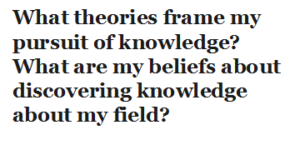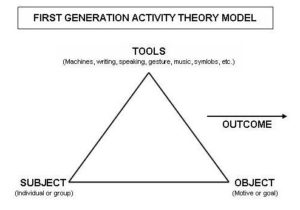I struggle in admitting I am an English professor. My students call me
“professor” and my mail comes to me with “professor” in the greeting, yet I still have a hard time introducing myself as such though I’ve been teaching at the collegiate level for five years—I usually just tell people, “I teach English.” “Professor” suggests that I have earned respect from my field and academia as a whole. The title suggests that I have studied, reflected, and can articulate where I align myself in my field. My  apprehensions about being called “professor” were affirmed when I was tasked with this blog post, and I began to realize the challenge—and value—in being able to articulate how I align myself theoretically and epistemologically. What theories frame my pursuit of knowledge? What are my beliefs about discovering knowledge about my field? Perhaps I have struggled to embrace my position as an educator because I had not before defined myself in these terms, and in doing so, I had not before claimed a position as a scholar in my field or in academia.
apprehensions about being called “professor” were affirmed when I was tasked with this blog post, and I began to realize the challenge—and value—in being able to articulate how I align myself theoretically and epistemologically. What theories frame my pursuit of knowledge? What are my beliefs about discovering knowledge about my field? Perhaps I have struggled to embrace my position as an educator because I had not before defined myself in these terms, and in doing so, I had not before claimed a position as a scholar in my field or in academia.
After much reflection, I found that I align myself theoretically with David Russell’s (1995) explanation of activity theory which “analyzes human behavior and consciousness in terms of activity systems.” Through the activity system, we see 1.) the subject, or the writer, who 2.) mediates the situation in order to 3.) achieve an objective or outcome (n. pag). In effect, the activity system takes on a triangular shape that depicts each aspect of the activity system as dependent on the other two. The subject chooses which tool he will use to mediate the situation (in this case, writing) and how he will use it, but whether or not he achieves the objective—or finishes his written assignment—depends on how well he uses his tool to manage the situation he is in. Ultimately, the writer is impacted by the tool and the objective, modifying his use of the tool and his understanding of the objective as he pushes forward to completion. Therefore, activity systems are social and negotiable, and as such, every activity system is unique. However, learners often struggle to apply the skills that were learned in one activity system to another activity system due to their inability to adapt those skills. While every activity system is unique, learners often fail to recognize the similarities between them.

It is activity theory that gives me a language with which I can study transfer, which Perkins and Salomon (1988) describe as “something learned in one context [that helps] in another” (p. 22). That something, often consisting of a single skill or a set of skills, is beneficial to learners, who are ultimately responsible for their own independent ability to successfully manage writing situations. Downs and Wardle hold that this management is best understood through Russell’s lens of activity theory. Hence, the Writing about Writing approach, first introduced to the field in 2007, was designed in part as a response to a long-standing discussion on how to promote transfer in first-year composition classrooms.
Epistemologically, I align myself with social constructivism, “wherein knowledge is understood to be dynamic, provisional, and developed and mediated socially as people operate within various ‘communities’ of knowledge.” Psychologist Lev Vygotsky, scientist Thomas Khun, and rhetorician Kenneth Bruffee have contributed to our current understanding of social constructivist epistemology (p. 33). In essence, our inner speech, or thoughts, are on a higher level than our verbal, or social speech (Vygotsky), and these inner thoughts are inspired by our interactions with the social world around us, which is complex, interdisciplinary, and shapes our knowledge (Kuhn). Therefore, collaborative learning strategies, or soc ial opportunities, enable us to use our higher level thoughts in conjunction with our surrounding environments that are working to shape our knowledge and in turn shape our output (e.g. verbal and written speech) (Brufee) (Hewett and Ehmann, 2004, pp. 34-37). Social constructivism allows me to make the teaching and learning experience transparent, which is essential to successful transfer as students leave my English classroom and enter into classrooms of other disciplines.
ial opportunities, enable us to use our higher level thoughts in conjunction with our surrounding environments that are working to shape our knowledge and in turn shape our output (e.g. verbal and written speech) (Brufee) (Hewett and Ehmann, 2004, pp. 34-37). Social constructivism allows me to make the teaching and learning experience transparent, which is essential to successful transfer as students leave my English classroom and enter into classrooms of other disciplines.
My theoretical and epistemological alignment are connected to my professional objectives as an educator and a faculty member at my current institution. I want students to understand the interconnectivity of the disciplines they are studying and the value of a liberal arts education. At the beginning of every semester I ask them, “What is a liberal arts education?” Their responses are limited to the idea that they need to be “well-rounded”—a reminder for me every semester that students need to see the social nature of learning and the activity systems in which they engage. A reminder that, as a professor, I am a window through which my students will view the university and the English discipline for 15 weeks, and I better know where I align myself in order to help align them.
References
Downs, D. & Wardle, E. (2007). Teaching about writing, righting misconceptions: (Re)envisioning “First-Year Composition” as “Introduction to Writing Studies.” CCC, 58(4), 552-584.
Hewett, B. and Ehmann, C. (2004). Preparing educators for online writing instruction. Urbana, IL: NCTE.
Perkins, D.N, & Salomon, G. (1988). Teaching for transfer. Educational Leadership, 46(1), 22-32.
Russell, D. (1995). Activity theory and its implications for writing instruction. In J. Petraglia (Ed.), In Reconceiving writing, rethinking writing instruction (51-78). Hillsdale, NJ: Erlbaum.

How fascinating! We have both approached transfer as a goal of first year composition and tie into “Writing about Writing,” but from different directions. I will admit that I was not familiar with activity theory, but I think I would be wise to read your resources, as well as follow along with your blog to see where you go from here. After all, professor, you do have five years’ worth of experience on me, so I am very happy to learn from you! A last comment; I think it is interesting that you ask students to define what a liberal arts education is, and that they are not able to answer. I wonder how many adults would be able to? Very few, I suspect, and even fewer would be able to explain why a liberal arts education is of such value.